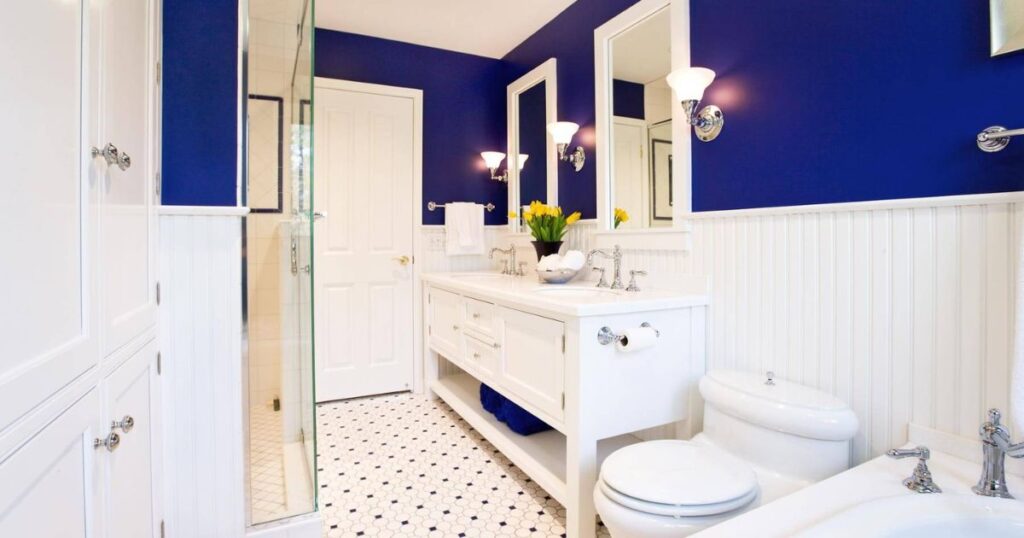When painting bathrooms, choosing the right type of paint is crucial. Bathrooms are high-moisture environments prone to mildew and peeling paint, so you want a finish that can withstand these conditions while looking great. In this comprehensive guide, we’ll cover everything you need to know about selecting the best paint for bathroom walls, ceilings, trim, and cabinets.
Best Paint Base for Bathrooms
Latex Paint
For most bathroom surfaces, latex paint is the way to go. It offers several key advantages:
- Moisture resistance: Latex paint is designed to withstand humid conditions, making it perfect for bathrooms where condensation and steam are common.
- Durability: Quality latex paints are tough and long-lasting, withstanding frequent cleaning and wear and tear.
- Easy cleanup: Latex paint cleans up easily with soap and water; no harsh solvents are required.
- Low or no VOCs: Many latex paints are low or no VOC (volatile organic compounds), making them a healthier choice for indoor spaces.
Top latex paint brands like Benjamin Moore Aura, Sherwin-Williams Emerald, and Behr Premium Plus are excellent bathroom options.
Oil-Based Paint
While latex is the primary recommendation for bathroom walls and ceilings, oil-based paint can be helpful in specific applications:
- Cabinets and trim: The extreme durability of oil-based paints makes them suitable for high-traffic areas like cabinets and door trim.
- Existing oil-based surfaces: If you’re repainting surfaces previously done with oil-based paint, it’s best to use an oil-based product for proper adhesion.
However, oil-based paints have some drawbacks:
- VOCs: They release higher levels of volatile organic compounds during application and drying.
- Yellowing: Oil-based paints can turn yellow over time, especially in areas with little natural light.
- Laborious Cleanup: Mineral spirits or paint thinners are required for cleanup, which can be messy.
Latex paint is generally the better choice for most bathroom surfaces unless you have a specific need.
Best Paint Finish for Bathrooms

In addition to the paint base, the finish or sheen level is crucial for achieving a durable, attractive bathroom. Here are the top options:
Semi-gloss or Gloss Finishes
For maximum moisture and mildew resistance, semi-gloss or gloss finishes are the gold standard for bathroom paint. Their key benefits include:
- Highly moisture-resistant: The sleek, enamel-like surface sheds water and condensation quickly.
- Scrubbable and washable: These ultra-tough finishes can withstand frequent cleaning without wearing down.
- Mildew-resistant: The tighter molecular structure makes it harder for mildew to penetrate and grow.
Semi-gloss is an excellent all-around choice for bathroom walls, while high-gloss paint is ideal for trim, cabinets, and frequently cleaned surfaces. However, these shiny finishes can highlight imperfections in your walls or surfaces.
Some top semi-gloss bathroom paint recommendations:
- Behr Premium Plus Semi-Gloss Enamel Interior Paint
- Valspar Reserve Semi-Gloss Enamel Interior Paint
- Benjamin Moore Advance Waterborne Interior Alkyd Semi-Gloss
Satin Finishes
Satin paint offers a nice compromise between flat and glossy finishes. Its key attributes include:
- Moderate sheen: Satin has a soft, velvety look with a hint of reflective properties.
- Moisture and scuff resistance: While not as waterproof as semi-gloss, satin finishes still provide good moisture and stain resistance.
- Easier to clean than flat paints: The slight shine makes satin paint easier to wipe down.
“Satin paints are a nice middle ground that offers moisture protection and easy cleaning but without an overwhelming shine.” – Bob Vila, Home Renovation Expert.
For bathrooms that don’t experience extreme humidity or condensation, a high-quality satin paint like Valspar Signature or BEHR Marquee can be an excellent choice for walls.
Flat, Matte, or Eggshell Finishes
While flat, matte, and eggshell finishes have their place in other areas of the home, they are generally not recommended for bathrooms due to their inability to withstand moisture and frequent cleaning. Key drawbacks include:
- Poor moisture resistance: The porous surface allows water to penetrate, leading to potential bubbling, peeling, and mildew growth.
- Difficult to clean: Any attempt at scrubbing these surfaces will likely mar or dull the finish.
- Shows imperfections: Flat finishes highlight bumps, dents, or textured surfaces on your bathroom walls.
The one exception is that eggshell or satin finishes may work in a seldom-used powder room with low humidity. But for primary bathrooms, stick with semi-gloss or satin finishes.
Best Paint for Bathroom Ceilings
Regarding bathroom ceilings, the key is choosing a durable, mildew-resistant paint that can withstand humid conditions. Semi-gloss paint is the ideal choice.
Semi-gloss’s sleek, moisture-shedding surface makes it far less prone to water staining and mildew growth than flat ceiling paints. And while glossy ceilings can create glare, most bathrooms have sufficient lighting to minimize this issue.
For powder rooms with less humidity, a satin finish may suffice. But for primary bathrooms, the extra semi-gloss protection can save you the hassle of dealing with an unsightly, mildew-stained ceiling down the road.
Warning
No matter which paint you choose for the ceiling, proper preparation is critical to preventing future mildew issues:
Always clean and remove any existing mildew before painting! Scrub affected areas with a bleach and water solution, and wear proper protective gear. Never simply paint over mildew; it will eventually grow through the new paint job.
After cleaning, apply a stain-blocking, mildew-resistant primer before your topcoats of paint. Quality primers like Zinsser Bullseye 123 Plus or KILZ Mold & Mildew Primer provide a mildew-resistant base for your bathroom ceiling paint.
Bathroom Hardware
Remember to coordinate with your existing or new hardware and fixtures once you’ve selected the perfect paint for your bathroom walls and ceiling. Consider these factors:
- Faucets and Shower Trim: The finish of your faucets, showerhead, towel bars, etc. Whether it’s brushed nickel, oil-rubbed bronze, or another metallic tone, choose wall and trim paint colors that complement these fixtures.
- Vanity Cabinets: If you have existing wood or laminate vanity cabinets, you can refinish or repaint them using a durable cabinet enamel paint in a coordinating tone.
- Tile and Flooring: Note the colors in your tile, stone, or vinyl flooring and choose bathroom paint colors that harmonize rather than clash.
Pulling inspirational photos of bathroom color schemes you love can help narrow down the perfect coordinating palette.
Colors
Selecting the right bathroom paint colors greatly impacts the overall look and feel. Here are some tips to consider:
- Light & Airy vs. Cozy & Warm: Light, cool colors like pale blues, greens, and grays can create an airy, spa-like bathroom atmosphere. Warmer tones like taupes, beiges, and terracotta hues provide a cozy, inviting vibe.
- Small vs. Large Bathrooms: Light and bright colors can help the space feel more open and airy in small bathrooms. Darker, moodier hues work better in larger bathrooms to create a cozier ambiance.
- Color Psychology: Blues and greens tend to be calming, while warm tones like reds and oranges are energizing. Consider the mood you want to achieve.
- Test Samples: Always test paint samples on your bathroom walls before committing. Lighting conditions can dramatically impact how a color appears.
Some popular, on-trend bathroom color palettes include:
- Soft whites, grays, and pale blues/greens for a serene, spa-inspired feel
- Nature-inspired olive greens, warm terracotta hues, and creamy neutrals
- Bold, saturated jewel tones like emerald, sapphire, and plum for a luxurious, high-contrast look
What to Consider When Choosing the Best Paint for Bathrooms

Beyond just color and finish, there are some key performance factors to weigh when selecting bathroom paint.
Wall Color Affect Mirror Reflections
The color you choose for your bathroom walls can impact your appearance in the mirror’s reflection. Here’s a quick guide:
- Cool Colors (blues, grays): Create a slightly washed-out, dull complexion
- Warm Colors (beiges, peaches): Result in a brighter, more radiant-looking skin tone
- Yellow/Green Undertones: Can cause sallow or jaundiced skin appearance
For the most flattering mirror reflection, opt for satin or semi-gloss paint in muted, rosy, neutral tones without too much yellow or green undertone.
Mold and Mildew Resistance
Bathrooms are prime targets for mold and mildew growth due to the persistent moisture and humidity levels. To prevent this fungal development:
- Choose paints specifically formulated with mildewcides to inhibit mold/mildew growth
- Look for paints with built-in moisture resistance to prevent water penetration
- Proper surface prep and priming are key (clean any existing mold first)
Top mold and mildew-resistant paint options include Zinsser Perma-White Mold & Mildew-Proof and KILZ Interior/Exterior Bathroom Paint.
Prevent Peeling
Nothing ruins a bathroom’s look faster than peeling, chipping paint. To avoid this:
- Use high-quality latex paints formulated for bathrooms
- Choose semi-gloss or satin sheens – flats are more prone to peeling
- Properly clean, prime, and prepare surfaces
- Use a peelable caulk or painter’s tape to create clean paint lines
Following the proper prep steps and using durable, moisture-resistant bathroom paints will ensure your paint job lasts.
Read More Posts
How To Paint Bathroom Cabinets: A Complete Guide For Transforming Your Space
Can You Paint The Bathroom Tile? Everything You Should Know
FAQs
What type of paint is best for a bathroom?
The best choice for bathroom paint is a moisture-resistant option like a semi-gloss or satin finish. These paints are designed to withstand the high humidity levels typically found in bathrooms, helping to prevent mold and mildew growth.
Do you have to use special paint for bathrooms?
It’s highly recommended to use special bathroom paint because of the unique challenges bathrooms present. Special bathroom paint formulations are engineered to resist moisture effectively, offering better protection against mold and mildew, which are common issues in bathrooms due to the constant exposure to moisture.
Is satin or gloss paint better for bathrooms?
Satin paint is generally considered better for bathrooms compared to gloss. Satin finishes offer a good balance of durability and sheen, providing a subtle shine without being too reflective. Additionally, satin paints are more forgiving in hiding imperfections on the walls and are easier to clean than gloss paints.
Is eggshell or satin better for bathrooms?
Satin paint is typically the superior choice for bathrooms. While eggshell finishes offer a subtle, low sheen like satin, satin paints have better moisture resistance and are easier to clean. This makes them more suitable for the high-humidity environment of bathrooms, where maintaining cleanliness and preventing moisture-related issues is essential.
Conclusion
Selecting the best type of paint for your bathroom requires careful consideration of factors like moisture and mildew resistance, color, sheen, and durability. Following this guide’s recommendations, you can create a beautiful, long-lasting paint finish tailored to your bathroom’s unique needs.
To recap the key takeaways:
- For walls and ceilings, opt for latex paint with a semi-gloss or satin sheen for maximum moisture resistance and cleanability.
- Pay close attention to color undertones, lighting, and mirror reflections when choosing wall colors.
- Properly prep surfaces by cleaning any mildew and using mildew-resistant primer.
- Consider using tough, oil-based paints for cabinets, trim, and high-wear areas.
- Coordinate with your bathroom fixtures, tile, and decor for a cohesive look.
With the right paint products and proper application, you can create a stunning bathroom that looks fantastic for years. For more personalized advice, don’t hesitate to consult professional painters or the experts at your local paint supply store.







